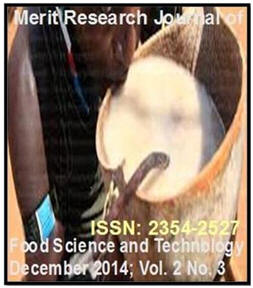
|
|
|
|
|
|
/ / MRJFST Home / / About MRJMFST / / Submit Manuscripts / / Call For Articles / / Editorial Board / / Archive / / Author's Guide / /
|
Other viewing option
• Full text •Reprint (PDF) (132 KB)
Ukwubile
CA
|
Original Research Article Production of Amylase Using Different Retting Methods during Retting of Cassava Tubers |
|||
|
Cletus Anes Ukwubile |
||||
|
Department of Basic and Applied
Sciences, Federal Polytechnic Bali, Nigeria Accepted September 12, 2014 |
||||
|
Abstract |
||||
|
This study looks
into the possibility of using waste cassava retting water as a
source of industrial amylase. It also compares the different
amylase activity levels using four different retting methods.
Different sizes of fresh cassava tubers were retted for fufu
production. The sizes include unpeeled whole tubers (UPWT),
peeled whole tubers (PWT), peeled sliced tubers (PST) and peeled
grated tubers (PGT). Two retting methods were considered, the
traditional method, in which the tubers were retted with tap
water and the modified method, in which the tubers were retted
in aseptic condition using sterile water and starter cultures.
In the traditional method, amylase activity of the retting water
increased daily reaching the peak of 2.75 µ /mol for UPWT, 4.53
µ /mol for the PWT, 4.60 µ /mol for PST, and 3.66 µ /mol for PGT
on the fourth day. Microorganisms in the retting water were
isolated daily and a total of nine organisms (Candida
tropicalis, Aspergillus sp, Staphylococcus aureus, Enterobacter
aerogenes, Lactobacillus coryneformis, Citrobacter aerogenes,
Rhizopus stolonifer, Saccharomyces cerevisiae and
Klebsiella aerogenes) were isolated. Five organisms were
able to ret the tubers and yield considerable amount of amylase.
These organisms were used as starter cultures to ret the peeled
sliced tubers. They yield a greater amylase activity with the
sample for Lactobacillus coryneformis yielding the highest
amount of up to 7.34 µ /mol. Since cassava processing to fufu is
usually accompanied with the production of stinking smelling
waste water which constitute nuisance to humans, animals and
aquatic life, the waste water can be utilized as a source of
industrial amylase to save our environment. |
Merit Research Journals© 2016 || Advertisement | Privacy policy.
